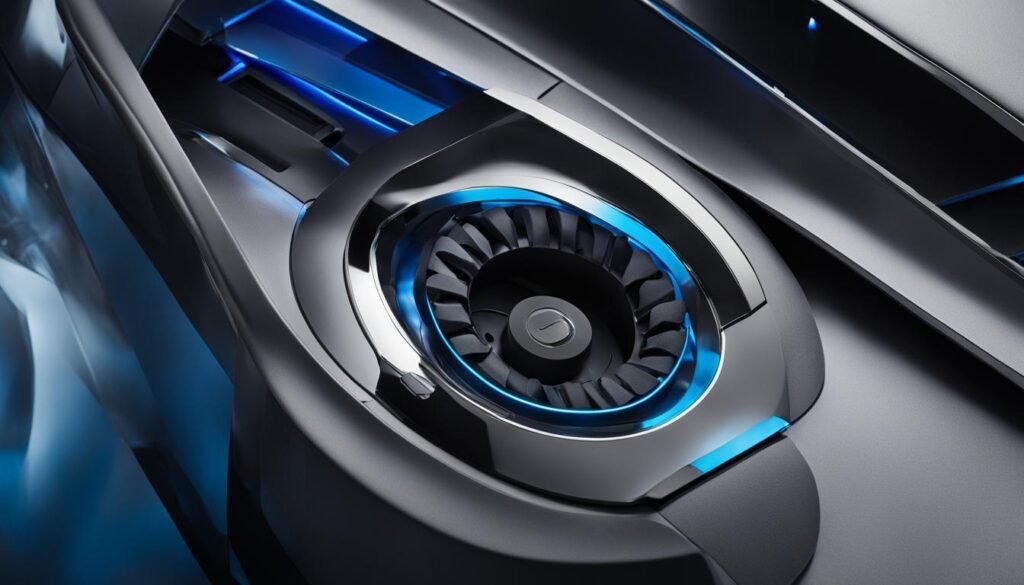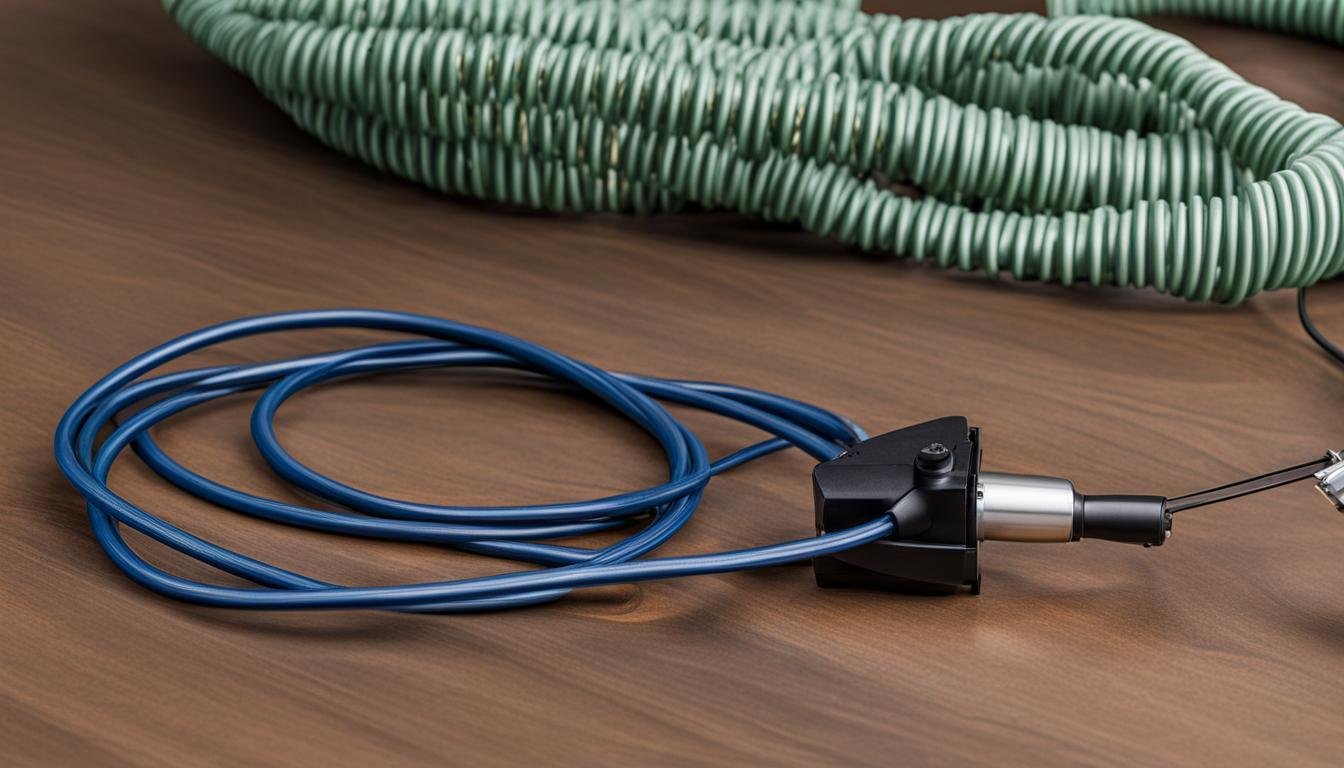Have you ever wondered how the cords of a vacuum cleaner magically retract, providing a tidy storage solution and hassle-free cleaning experience? Well, you’re not alone. In the past, we had to manually wind and unwind the power cord every time we wanted to use our vacuum cleaner. But thanks to advancements in technology, vacuum cleaner manufacturers have introduced cord retraction systems that have revolutionized the way we clean.
These innovative systems utilize a cord winding mechanism housed within the vacuum cleaner assembly. When not in use, the power cord is safely stored inside the device, preventing damage and eliminating the need for manual cord management. With a simple action like a snap of the wrist or pressing a button, the cord automatically retracts, ready for the next cleaning session.
Key Takeaways:
- Cord retraction systems in vacuum cleaners provide a convenient and efficient way to manage the power cord.
- Retractable cords work using a mechanism that includes rotatable wheels inside a storage space.
- Early patents for cord winding mechanisms date back to the early 1900s.
- Vacuum cleaners with cord retraction systems offer hassle-free cleaning and tidy storage solutions.
- Embracing cord rewind technology simplifies the cleaning experience and keeps our homes clean and fresh.
How Do Retractable Cords Work
Retractable cords in vacuum cleaners utilize a sophisticated cord winding mechanism to provide users with a seamless cord retraction system. This innovative technology ensures efficient cord management and eliminates the hassles of dealing with tangled cords.
At the core of retractable cord technology are rotatable wheels located within a dedicated storage space that accommodates the entire length of the cord. When a user pulls the cord to extend it, the ratchets automatically engage, effectively locking the cord in place and preventing it from rolling back up into its original storage position.
When it’s time to retract the cord, a simple action such as a snap of the wrist or pressing a button disengages the ratchets. This allows the cord to smoothly retract back into the storage space, effortlessly winding itself up.
This cord retracting mechanism offers users a convenient and efficient way to manage the cord, preventing it from becoming tangled or cluttered. By eliminating the need for manual winding, users can enjoy a hassle-free cleaning experience with minimal effort.
The Evolution of Cord Retraction in Vacuum Cleaners
The concept of cord retraction in household appliances, including vacuum cleaners, has a long history that dates back to the early 1900s. The need for cord management in various devices was recognized early on, leading to the development of cord winding mechanisms.
In 1939, a patent was awarded for a vacuum cleaner handle with a spring-operated drum, allowing users to control the rewinding of the electrical cord. This innovation provided a more convenient way to store the cord and avoid tangles and clutter. The concept of retractable cords in household appliances was gaining traction.
Another significant patent was granted in 1971, covering an electrical cord retracting mechanism. This invention further advanced cord retraction technology, paving the way for the cord retraction systems we see in vacuum cleaners today.
The early pioneers and inventors laid the foundation for modern vacuum cleaners with cord retraction capabilities. Their innovative designs not only improved cord management but also enhanced the overall user experience. Vacuum cleaners equipped with retractable cords have become a staple in households, offering convenience and efficiency during cleaning tasks.
Patent from 1939
“An improved vacuum cleaner handle, incorporating a spring-operated drum for automatic rewinding of the electrical cord.”
Patent from 1971
“A cord retracting mechanism for household appliances, providing a convenient storage solution for electrical cords.”

These early cord retraction patents and inventions have paved the way for the cord management systems integrated into modern vacuum cleaners. With the ability to automatically retract the cord, vacuum cleaners offer users a tidy storage solution and a hassle-free cleaning experience.
Conclusion
The development of cord retraction systems in vacuum cleaners has revolutionized the way we clean. With the ability to automatically retract the cord, users no longer need to manually wind and unwind the power cord after each use. This vacuum cleaner cord management feature provides convenience and efficiency, making cleaning tasks more manageable and enjoyable.
One of the key benefits of cord retraction is hassle-free cleaning. Instead of dealing with tangled and messy cords, users can simply press a button or snap their wrist to retract the cord effortlessly. This saves valuable time and eliminates the frustration of untangling knots.
Moreover, vacuum cleaners with cord rewind technology offer tidy storage solutions. The retractable cord neatly coils inside the vacuum cleaner, keeping it out of the way and preventing tripping hazards. This not only enhances safety but also minimizes clutter in your cleaning space.
In conclusion, embracing cord retraction technology in vacuum cleaners has transformed the cleaning experience. By eliminating the manual management of cords, users can focus on what matters most – keeping their homes clean and fresh. With the convenience, efficiency, and tidy storage solutions provided by cord retraction systems, it’s no wonder that vacuum cleaners with this feature have become a popular choice for households seeking hassle-free cleaning.
FAQ
How do the cords of a vacuum cleaner retract?
The cords of a vacuum cleaner retract using a mechanism that includes rotatable wheels inside a storage space. When the cord is pulled to extend it, ratchets automatically lock to prevent it from rolling back up. To retract the cord, a simple action such as a snap of the wrist or pressing a button disengages the ratchets, allowing the cord to retract back into the storage space.
How do retractable cords work?
Retractable cords in vacuum cleaners work using a mechanism that includes rotatable wheels inside a storage space. When a user pulls the cord to extend it, ratchets automatically lock, preventing the cord from rolling back up into its original storage position. To retract the cord, a simple action such as a snap of the wrist or pressing a button disengages the ratchets, allowing the cord to retract back into the storage space.
What is the evolution of cord retraction in vacuum cleaners?
The concept of cord retraction in household appliances, including vacuum cleaners, is not a recent development. Patents for cord winding mechanisms date back to the early 1900s, demonstrating the early recognition of the need for cord management in various devices. These early inventions laid the foundation for the cord retraction systems we see in vacuum cleaners today.
Why is cord retraction important in vacuum cleaners?
Cord retraction in vacuum cleaners provides convenience and efficiency. With the ability to automatically retract the cord, users no longer need to manually wind and unwind the power cord after each use. This technology offers a tidy storage solution and a hassle-free cleaning experience, making cleaning tasks more manageable and enjoyable.





Leave a Reply